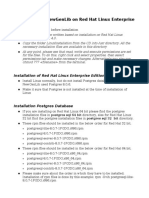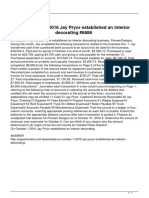0 ratings0% found this document useful (0 votes)
2 viewsinstalling-postgres-17-using-source-files
This document provides a step-by-step guide for installing PostgreSQL 17 from source files on a CentOS 10 EC2 instance. It outlines the necessary packages, user creation, downloading and configuring PostgreSQL, and initializing the database cluster. The guide emphasizes the benefits of source installation, such as customization and development opportunities.
Uploaded by
Rekesh PatelCopyright
© © All Rights Reserved
We take content rights seriously. If you suspect this is your content, claim it here.
Available Formats
Download as PDF, TXT or read online on Scribd
0 ratings0% found this document useful (0 votes)
2 viewsinstalling-postgres-17-using-source-files
This document provides a step-by-step guide for installing PostgreSQL 17 from source files on a CentOS 10 EC2 instance. It outlines the necessary packages, user creation, downloading and configuring PostgreSQL, and initializing the database cluster. The guide emphasizes the benefits of source installation, such as customization and development opportunities.
Uploaded by
Rekesh PatelCopyright
© © All Rights Reserved
We take content rights seriously. If you suspect this is your content, claim it here.
Available Formats
Download as PDF, TXT or read online on Scribd
You are on page 1/ 4
Installing Postgres 17 using source files
Dear readers,
In this document, I’ll show you how to install PG 17 using source files.
Various methods to install PG
1. YUM: From Linux machine run yum install and required PG packages will be downloaded from the
internet
2. RPM: Download required PG packages (.rpm) from internet to the Linux machine and then install those
packages via rpm
3. Source files: Download required PG source files from internet to the Linux machine, compile them and
then install.
Reasons to choose source files installation over other methods:
1. You want to use some customized PG options/settings e.g. Use different block size than default 8Kb or
want bigger WAL files than default 16 MB etc.
2. You want to develop a custom PG release of yours.
3. You found an are to improveme in PG and want to introduce that in PG
4. And many more
I have a CentOS 10 EC2 of t2.micro size (as it’s available for free and suits to our purpose), so let’s begin.
1. Installing the necessary packages:
a. gcc: To compile and execute PG core files
b. make: As PG is written in C language, it’s core files will be complied and executed using make
utility. Makefile is a special file that has entries of the files to be compiled and then run (resulting
into PG installation in our case).
c. zlib-devel: To support various PG compression algorithms
d. wget: To download PG files from the internet
e. libucu-devel: Development files for International Components for Unicode
f. bison: Needed for debugging PG parser grammer
g. flex: A tool for generating scanners (text pattern recognizers)
h. perl: Neede for OpenSSL configuration option
i. readline-devel: To provide history in psql (when we hit up arrow, we can see previous
commands we executed)
[root@ip-172-31-31-68 ~]# cat /etc/redhat-release
CentOS Stream release 10 (Coughlan)
[root@ip-172-31-31-68 ~]# yum install -y gcc readline-devel make zlib-devel openssl-devel
wget libicu-devel bison flex perl
2. Creating postgres user and directories for PGDATA, PG binaries
[root@ip-172-31-31-68 ~]# useradd -d /home/postgres -U postgres
[root@ip-172-31-31-68 ~]# echo postgres | passwd "postgres" --stdin
BAD PASSWORD: The password contains the user name in some form
Created by Amol V. Palav [+91 7045443328] Page 1
[root@ip-172-31-31-68 ~]# mkdir -p /pgdata/17/main
[root@ip-172-31-31-68 ~]# chown -R postgres:postgres /pgdata
[root@ip-172-31-31-68 ~]# chmod -R 755 /pgdata
[root@ip-172-31-31-68 ~]# mkdir -p /home/postgres/bin/pgsql/17
[root@ip-172-31-31-68 ~]# chmod -R 755 /home/postgres/bin/pgsql/17
[root@ip-172-31-31-68 ~]# chown postgres: /home/postgres/bin/pgsql/17
3. Downloading and unzipping PG binaries
[root@ip-172-31-31-68 ~]# cd /tmp
[root@ip-172-31-31-68 tmp]# wget https://ftp.postgresql.org/pub/source/v17.2/postgresql-
17.2.tar.gz
[root@ip-172-31-31-68 tmp]# ls -lh postgresql-17*
[root@ip-172-31-31-68 tmp]# gunzip postgresql-17.2.tar.gz
[root@ip-172-31-31-68 tmp]# tar -xpf postgresql-17.2.tar
[root@ip-172-31-31-68 tmp]# cd postgresql-17.2
[root@ip-172-31-31-68 postgresql-17.2]# ls -lh
4. We can see configure utility that’ll help us to install PG using various options. We can see various
options this utility provides using below command
[[root@ip-172-31-31-68 postgresql-17.2]# ./configure --help
Created by Amol V. Palav [+91 7045443328] Page 2
5. Generating PG binaries (kind of a PG home where various utilities will reside e.g. psql, pg_dump)
[root@ip-172-31-31-68 postgresql-17.2]# ./configure --prefix=/home/postgres/bin/pgsql/17 --
with-openssl
[root@ip-172-31-31-68 postgresql-17.2]# make
[root@ip-172-31-31-68 postgresql-17.2]# make install
6. Generating an environment file/profile for postgres user
[root@ip-172-31-31-68 postgresql-17.2]# echo '
alias lt="ls -ltrh"
alias lta="ls -ltrha"
alias cl="clear"
alias lk="ps -ef | grep "
alias lki="ps -ef | grep "
export PGDATA=/pgdata/17/main
export PATH=/home/postgres/bin/pgsql/17/bin:$PATH
export LD_LIBRARY_PATH=/home/postgres/bin/pgsql/17/lib:$LD_LIBRARY_PATH
' >> /home/postgres/.bash_profile
[root@ip-172-31-31-68 postgresql-17.2]# chmod 755 /home/postgres/.bash_profile
[root@ip-172-31-31-68 postgresql-17.2]# chown postgres: /home/postgres/.bash_profile
Created by Amol V. Palav [+91 7045443328] Page 3
7. Initializing and starting the PG cluster via postgres user
[root@ip-172-31-31-68 postgresql-17.2]# sudo su - postgres
[postgres@ip-172-31-31-68 ~]$ which initdb
~/bin/pgsql/17/bin/initdb
[postgres@ip-172-31-31-68 ~]$ echo $PGDATA/
/pgdata/17/main/
[postgres@ip-172-31-31-68 ~]$ initdb -D $PGDATA –k
[postgres@ip-172-31-31-68 ~]$ pg_ctl -D $PGDATA/ start
8. Verification
[postgres@ip-172-31-31-68 ~]$ pg_ctl -D $PGDATA/ status
# from psql prompt
postgres=# select version();
postgres=# show data_checksums;
Created by Amol V. Palav [+91 7045443328] Page 4
You might also like
- Fire Suppression Systems UL 300: Length of Hood100% (2)Fire Suppression Systems UL 300: Length of Hood3 pages
- Postgresql Installation Using Source Code in LinuxNo ratings yetPostgresql Installation Using Source Code in Linux4 pages
- How To Install Postgresql 11 On Linux Mint 19 TaraNo ratings yetHow To Install Postgresql 11 On Linux Mint 19 Tara6 pages
- REquirement - For Instalation - PostgresqlNo ratings yetREquirement - For Instalation - Postgresql1 page
- Installing Adempiere With Postgresql 8.2No ratings yetInstalling Adempiere With Postgresql 8.213 pages
- Installing PostgreSQL From A Yum RepositoryNo ratings yetInstalling PostgreSQL From A Yum Repository10 pages
- Bersania - Postgresql Installation On Ubuntu - BWNo ratings yetBersania - Postgresql Installation On Ubuntu - BW3 pages
- RDBMS-PostgreSQL-Installation-Sheet-EnglishNo ratings yetRDBMS-PostgreSQL-Installation-Sheet-English2 pages
- Postgres - 11 Instalation Via Source Code - txt-1No ratings yetPostgres - 11 Instalation Via Source Code - txt-14 pages
- Deploy RDS@PostgreSQL-16 & Connect Via PSQL From Another HostNo ratings yetDeploy RDS@PostgreSQL-16 & Connect Via PSQL From Another Host2 pages
- PostgreSQL Proficiency For Python PeopleNo ratings yetPostgreSQL Proficiency For Python People215 pages
- 13. Advanced SQL Injections - @CyberFreeCoursesNo ratings yet13. Advanced SQL Injections - @CyberFreeCourses57 pages
- PostgreSQL DBA - 9.6 Server InstallationNo ratings yetPostgreSQL DBA - 9.6 Server Installation7 pages
- How To Install PostgreSQL 9.3 and PhpPgAdmin in CentOS 6No ratings yetHow To Install PostgreSQL 9.3 and PhpPgAdmin in CentOS 69 pages
- Introduction To Dbms Lab Installation of Postgresql On Windows 10No ratings yetIntroduction To Dbms Lab Installation of Postgresql On Windows 1016 pages
- Downloading and Installing Postgresql On Windows 10No ratings yetDownloading and Installing Postgresql On Windows 104 pages
- Configuration of a Simple Samba File Server, Quota and Schedule BackupFrom EverandConfiguration of a Simple Samba File Server, Quota and Schedule BackupNo ratings yet
- CISCO PACKET TRACER LABS: Best practice of configuring or troubleshooting NetworkFrom EverandCISCO PACKET TRACER LABS: Best practice of configuring or troubleshooting NetworkNo ratings yet
- Configuration of a Simple Samba File Server, Quota and Schedule BackupFrom EverandConfiguration of a Simple Samba File Server, Quota and Schedule BackupNo ratings yet
- These Notes Will Serve As A Guide To Installing PostgreSQLNo ratings yetThese Notes Will Serve As A Guide To Installing PostgreSQL19 pages
- Distribution For Postgresql Documentation: 15.3 (June 28, 2023)No ratings yetDistribution For Postgresql Documentation: 15.3 (June 28, 2023)112 pages
- 15647/Ltt Guwahati Ex Sleeper Class (SL)No ratings yet15647/Ltt Guwahati Ex Sleeper Class (SL)2 pages
- 2019 Johor Biology K2 SET B Jawapan - Ms.enNo ratings yet2019 Johor Biology K2 SET B Jawapan - Ms.en16 pages
- Entrepreneurial Orientation (EO) :: Question 1b. AnswerNo ratings yetEntrepreneurial Orientation (EO) :: Question 1b. Answer8 pages
- Nestle Marketing Communication Children PolicyNo ratings yetNestle Marketing Communication Children Policy6 pages
- Standard Test Method For Field Vane Shear Test in Saturated Fine-Grained SoilsNo ratings yetStandard Test Method For Field Vane Shear Test in Saturated Fine-Grained Soils8 pages
- Curriculum Internationalization:: The Case of An Iranian UniversityNo ratings yetCurriculum Internationalization:: The Case of An Iranian University11 pages
- Univolt Is Formulated To Improve Performance and Extend Transformer LifeNo ratings yetUnivolt Is Formulated To Improve Performance and Extend Transformer Life2 pages
- Career Astrology: Which Career Is Best For Me According To My Birth Chart and d10 Chart?100% (2)Career Astrology: Which Career Is Best For Me According To My Birth Chart and d10 Chart?5 pages
- On October 1 2016 Jay Pryor Established An Interior DecoratingNo ratings yetOn October 1 2016 Jay Pryor Established An Interior Decorating1 page
- Natural Gas Dehydration Process Simulation and Optimisation A Case Study of Jubilee FieldNo ratings yetNatural Gas Dehydration Process Simulation and Optimisation A Case Study of Jubilee Field10 pages
- Difference Between Deciduous & Permanent DentitionNo ratings yetDifference Between Deciduous & Permanent Dentition17 pages

























































































